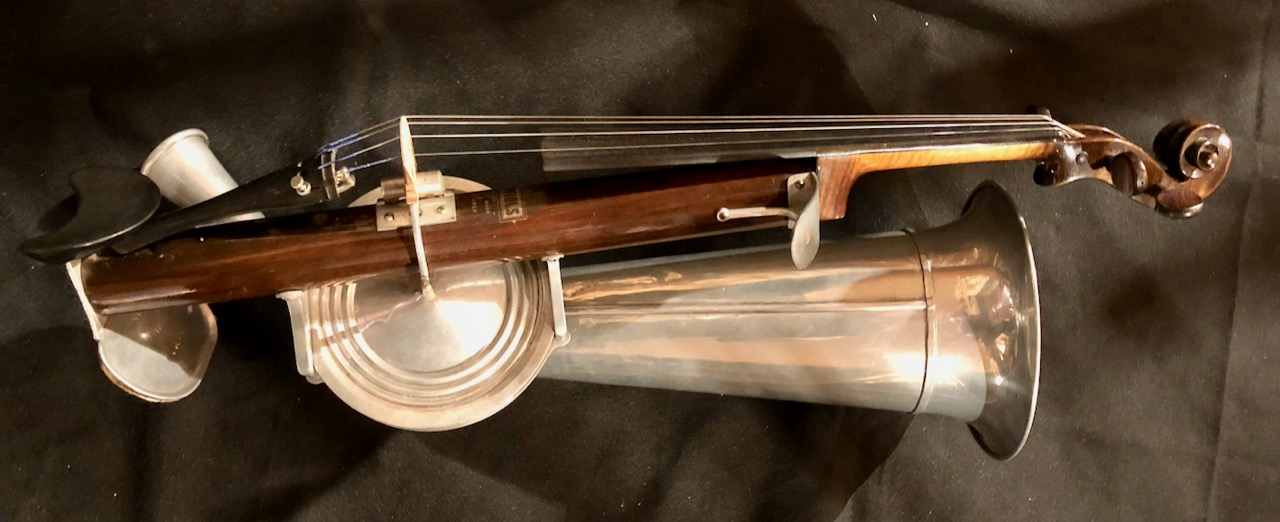Welcome to our forum. A Message To Our New and Prospective Members . Check out our Forum Rules. Lets keep this forum an enjoyable place to visit.
Currently working on errors from the latest (SimplePress) forum update. Many issues have been resoled and others are being worked on. Thank you for your patience.
 Topic RSS
Topic RSS



 (4 votes)
(4 votes) Regulars
 Offline
Offline








Klezmer music is unique genre and deserves the spotlight!
Known for unique effects meant to express profound feelings, and also a liberal use of grace notes.
I don't have time to get into the nitty gritty of it today, but wanted to start this thread by sharing a rather slow (3/8 time) & lovely piece that I want to learn by Harry Kandel (rolling sheet music - fiddle castro).
...feelin' it!
- Emily
Regulars
 Offline
Offline





Regulars
 Offline
Offline








Mimi Rabson has taught wonderful Workshops at the two Fiddle Hell Festivals I have attended!
The 'Stroh' Violin was very popular during the beginning of the recording era, because it helped concentrate the sound of the violin in the direction of the recorder.

...very interesting & great way to get that 'Old Phonograph Sound'!
- Emily
Regulars
 Offline
Offline





Regulars
 Offline
Offline








Found 3 really FABULOUS Klezmer Fiddle lessons from Michael Levy!
Points out that 'Klezmer' means 'Vessel of Song' and refers to the musicians who played for weddings.
So, YOU can be a 'Klezmer', even if you aren't Jewish!
He describes his unusual fiddle and intro to the 'Ahava Raba' scale, in this 1st lesson.
How To Play The Klezmer Fiddle (No.1)
Intro to the 'Misheberakh' scale.
How To Play Klezmer Fiddle (No.2)
Updating Klezmer for EV.
How To Play Klezmer Fiddle (No.3)

- Emily
Regulars
 Offline
Offline








Just found excerpts from an AMAZING Klezmer piece, "Klezmer Fantasy For Clarinet and String Quartet" arranged by Harold Seletsky - with extremely well detailed score displayed (Robin Seletsky)!
This is just a sample, the sheet music is available for purchase - but I see a lot to learn just from this free sample!
Turns out there's quite a few 'Klezmer Fantasies' - all by different composers!
According to Wikipedia, "Fantazi or fantasy is a freeform song, traditionally played at Jewish weddings to the guests as they dined. It resembles the fantasia of "light" classical music."
Much more here on; style, 'dance & non-dance music', orchestration, structure and history.

...wish ALL sheet music was notated this thoroughly. 😁
- Emily
Regulars
 Offline
Offline








Here's a playlist of 5 Klezmer Tutorials, taught by Igor Polesitsky.
How to Play Klezmer Music on Violin - Tutorial Playlist
These are interesting and he has a little different style of playing than I usually see for Klezmer.
💥 I should point out - it is common to use higher fingering positions for Klezmer music, along with double stops, slides and ornaments.
Haven't really talked about Klezmer modes, most Klezmer is in one of the minor modes.
These are the most common scales.
Seems Klezmer is a unique genre of folk music!
- Emily
Regulars
 Offline
Offline






This isnt the exact movie I was looking for. That one was around 20 minutes or so and featured an American fiddler traveling through Eastern Europe seeking out music at different villages. I believe it was shared on this forum or possibly fiddlehangout..regardless, cant find it now. This is a good documentary though. Fits the topic I hope. What I know about this style is what Ive read on this forum and a handful of videos so if not the same as youve started let me know.
Regulars
 Offline
Offline








@ABitRusty -
Hey, GREAT doc!
...sure felt sorry for the Double Bass player. (lol)
Been trying to figure where Gypsy music fits in & this may be the perfect spot!
I just started to learn a little about gypsy music in Hungary & Romania - while I was digging around for origins of the 'Haunting French' music. I'm convinced they migrated to Paris, maybe thru associations with the Circus, which became HUGE and made an everlasting impact on the music - late 19th & early 20th Century!
Gypsy music definitely has similarities to Klezmer - as seen here... with a bit of humor.
Read somewhere that Gypsy music predated Klezmer.
Here's some great fiddling and a little insight into the plight of the Gypsies.

Thanks for bringing this subject up!
Have a HAPPY THANKSGIVING!
- Emily
Regulars
 Offline
Offline








You MUST put your heart and soul into this music! 🤗
Among those stylistic elements that are considered typically "Jewish" in Klezmer music are those which are shared with cantorial or Hasidic vocal ornaments, including dreydlekh ("tear in the voice") and imitations of sighing or laughing ("laughter through tears"). Various Yiddish terms were used for these vocal-like ornaments such as קרעכץ (Krekhts, "groan" or "moan"), קנײטש (kneytsh, "wrinkle" or "fold"), and קװעטש (kvetsh, "pressure" or "stress"). (Wikipedia)
Here's some MICRO-lessons to get started!
Masterclass: Alicia Svigals on klezmer. 1: Running semiquavers
Masterclass: Alicia Svigals on klezmer. 2: Playing the zhok
Masterclass: Alicia Svigals on klezmer. 3: Krekhts
Masterclass: Alicia Svigals on klezmer. 4: Slides
Masterclass: Alicia Svigals on klezmer. 5: Bends
Masterclass: Alicia Svigals on klezmer. 6: Trills
AND! One, fabulous hour & a half long Workshop - recorded wit Alicia Svigals!

Yiddish Klezmer music is Jewish music from Central and Eastern Europe - SAME areas as Gypsies!
- Emily
Regulars
 Offline
Offline








Chris Haigh has 18 wonderful Klezmer Video Tutorials!
This recent one, really caught my eye - about the Freygish, Ahava Raba Mode/Scale!
Here's a link to his full Klezmer playlist:
Learn Klezmer Fiddle - Chris Haigh Video Tutorial Playlist
Found this great little "Yiddish Mazurka", while digging in diatonic accordion music. Rolling sheet music to learn, then you can try to apply some of the expressive elements from this and previous posts!

Keep that Fiddle out & play a tune!
- Emily
1 Guest(s)


 Log In
Log In Register
Register










